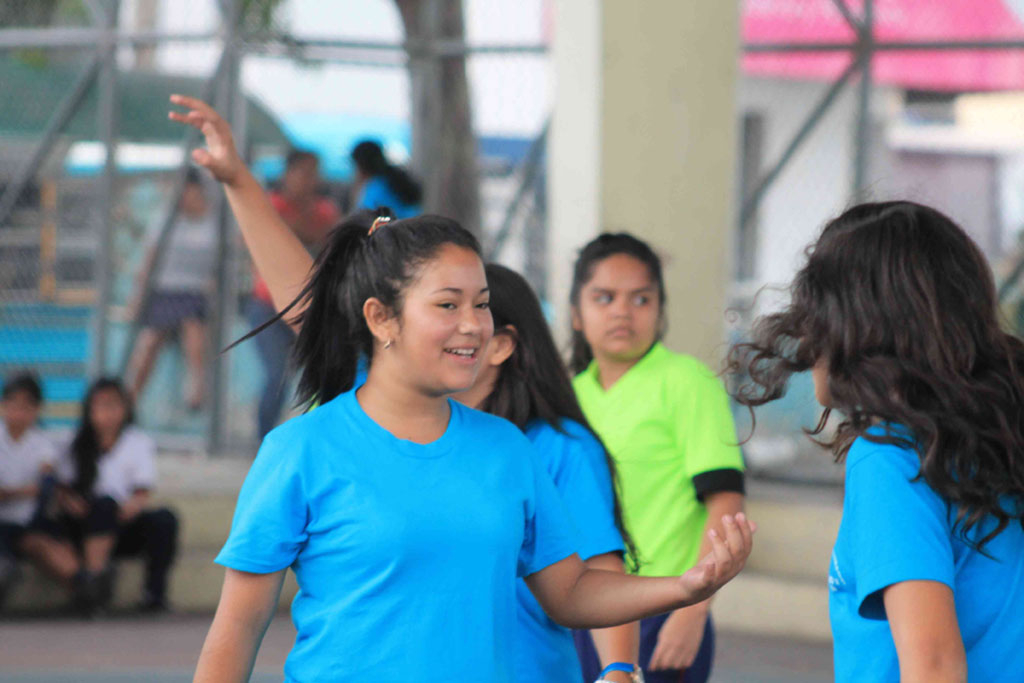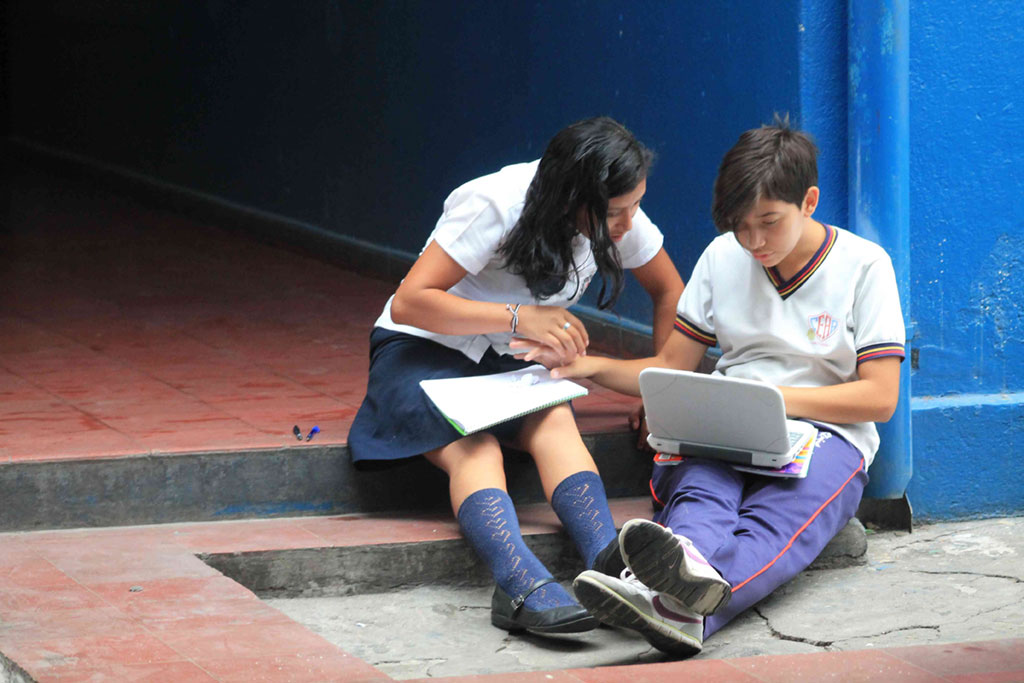Fourteen-year-old María was rebellious and had a reputation at school for not following the rules.
Maria’s reputation as a troublemaker preceded her at school, says Xiomara Guadalupe Ordóñez de Argueta, an experienced teacher at the Colegio Anita Alvarado in Cojutepeque, El Salvador, a community of 70,000 residents located about 20 miles from the nation’s capital.
“When I was told I would be teaching seventh grade, I thought, ‘Oh my God, the girls that I’m going to be with!’ The first thing I thought of was María, who was a big challenge. I had heard about her and how she was at the principal’s office because she was getting in trouble with girls in other classes, and I thought, ‘That’s what I’m going to have to deal with!” says Ordóñez de Argueta.
Beyond being disruptive in school, María was well on her way to becoming part of an alarming statistic in her native El Salvador: the increasing number of youth who could turn to a life of crime and violence.
Identifying & addressing risk factors
Fortunately, the school year for María, her classmates and the teacher took an abrupt and positive turn.
A special program in selected communities surveyed more than 1,000 youth ages 10 to 15 to determine whose behaviors or circumstances place them in a high risk category—including any drug use, association with gang members, family members who have migrated to another country and even access to recreational spaces.
María and more than 100 other youth in her community were selected to participate in an intensive, structured program that focuses on changing these dynamics at home and school. Called the Family Module, it brings in social workers, psychologists and educators to work with the youth and their families.

Modelo Familiar is one of several key components of the El Salvador Crime and Violence Prevention Project, an innovative endeavor funded by the U.S. Agency for International Development and implemented by Creative Associates International.
The five-year, $24 million project has three key components: Providing technical assistance to the Salvadoran government to prevent crime and violence at the national level; reducing crime and violence in 55 municipalities; and the promotion of innovative prevention practices.
It carries out the plan by using six strategies—ranging from the development of crime prevention policies to creating employment opportunities. From sports and arts to providing safe spaces, the project is helping communities to turn the tide of violence and crime.
“The idea of this project is to reduce violence and to contribute to citizen security,” says Harald Sibaja, Chief of Party for the USAID El Salvador Violence and Crime Prevention Project. “Based on our experience of many years working in Central America [on] crime prevention and the issue of gangs, we have gotten to understand those risk factors that really affect youth.”
Those risk factors include low self-esteem, limited access to education, low quality of education and high unemployment among youth, among others.
“Challenge of Dreaming My Life” methodology
“We’re trying to contribute by reducing those risk factors that make youth more vulnerable to becoming involved in gangs and to strengthen those positive factors that could give them some sort of sense to their lives [and] opportunities,” adds Sibaja. “We have developed a methodology that we call the Challenge of Dreaming My Life. We have programs supporting parents, how to supervise their kids better.”
The Challenge of Dreaming My Life concept stresses that life is about more than today. Through a series of organized steps, it takes the youth out of their present situation and guides them in developing plans for a brighter future.
The Challenge of Dreaming My Life methodology was developed as part of the Guatemala Youth Challenge Alliance program, which was supported by the U.S. Agency for International Development and implemented by Creative. In addition to El Salvador, the methodology is used by Creative in Honduras.

Maria’s mother felt her daughter was a prime candidate for this type of an intervention.
“We used to not have a good relationship because she was very rebellious,” says María Luz Gómez de Avendaño, Maria’s mother. “You couldn’t say a thing to her because she just wouldn’t listen. She wouldn’t pay attention to us. She was just paying attention to her friends at school and we were getting desperate. Her type of friends were the problem.”
On top of that, Gómez de Avendaño says, they didn’t get out much because they lived in an area prone to gang violence.
“The gangs are never up to any good and we wanted to stay away from that, so we went out only when it was necessary,” Maria’s mother says. “And I would tell her to be careful with her friends because sometimes friends are what ruins you, but she wouldn’t listen.”
Maria’s turnaround
Reflecting on her behavior, María doesn’t dispute the way she acted.
“I was undisciplined. I didn’t listen, and I liked to cause a ruckus,” she says. “I don’t even know why. I just liked to be rebellious. My friends were like that, too. We just all misbehaved. I know that my parents were worried.”
María says when she first entered the program, she had a chance to become involved in some hands-on projects and also talk about her life with a trained counselor, and the two developed a trusting relationship.
“I started to feel better about myself and I started to get along with people,” María says. “I even started playing up the flute. Now I turn in my homework, I don’t get into trouble, and I don’t end up in the principal’s office. Now I want to be a music teacher. At first I thought I wanted to be a policewoman, but I really love music and I’d like to teach it to others. My parents are very proud of me. The program has helped me a lot, and I think it could help many more kids.”
Maria’s mother noticed a transformation when the 14-year-old and the rest of the family entered the Family Module.
“I noticed that she just wasn’t the same rebellious kid as before,” Gómez de Avendaño says. “It has benefitted me also. It has helped me get closer to my daughter.”
“The program has helped me a lot and I think it could help many more kids.” Maria, 14 years old
Before the program, when Maria pushed her mother in a rebellious way, Gómez de Avendaño pushed back the same aggressive way.
“But thanks to the program, we are now friends. She talks with me and trusts me, and we didn’t have that before. Nowadays we talk about how the program is working out for her and how she doesn’t disrupt much in the classroom. I am very happy because I see the difference in her. I thought I had lost her,” Gómez de Avendaño says.
María’s teacher, Ordónez de Argueta, can’t say enough about the program and how much it has benefitted the 14-year-old student.
“If she weren’t in the program, we probably would have had a lot of problems. She’s a very bright girl and has a lot of aptitude for the arts, and now she’s helping me organize a dance group. One of the best decisions they made was to recommend her for the program. It’s a real blessing for her and for us,” she says.
Karen Marisol Pérez García, age 13, considers herself to be one of Maria’s closest friends, and she too has noticed a clear change in her friend’s behavior and outlook for the future.
“She’s told me several times how she wants to change for the better and she dreams of being a policewoman. She has a lot of dreams, like wanting to play the saxophone,” says Pérez García. “She says ‘I want to change’ and I tell her, ‘yes, because last year we had too many problems and we’d end up in the principal’s office. Nobody wants to be known to have a bad reputation’.”
Reported from El Salvador by Michael J. Zamba and Rene Urrutia.
